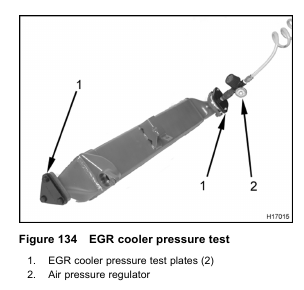Symptom
• Coolant residue at exhaust manifold flanges
• Observation of coolant loss without engine overheating
• Excessive white smoke from exhaust pipe on start up (hot or cold)
• Coolant smell in exhaust
• Coolant leaking from muffler
• Severe case – engine hydraulic lock
Cause
• Failed EGR cooler
• Injector cup and gasket leak
• Intake side of cylinder head cup plugs leaking
• Porosity in cylinder head casting
Tools
• Regulated compressed air
• Water supply housing pressure adapter
• Radiator pressure testing kit and plastic surge cap adapter
• EGR cooler pressure test plates (2)
Procedure

1. Remove EGR crossover tube assembly following the procedure in the Engine Service Manual.
2. Check for presence of coolant in EGR cooler and tube.
3. Plug in the cylinder block heater to warm coolant.
4. Install radiator pressure tester with the appropriate adapter.
5. Pressurize cooling system to 96 kPa (14 psi).
6. Check EGR cooler for the presence of coolant.
• If coolant is present, replace EGR cooler following the procedure in the Engine Service Manual.
• If no leak is found, do step 7.
If pressure is dropping rapidly, coolant may be leaking from the EGR cooler into the exhaust
manifold or tail pipe.
7. Drain coolant from the system.
8. Remove EGR cooler following the procedure in the Engine Service Manual.

9. Bolt EGR cooler pressure test plates to each end of the cooler assembly.
10. Use regulated air pressure and apply no more than 207 kPa (30 psi) to the EGR cooler assembly.
11. Submerge the EGR cooler assembly into a tank of water. Watch for air bubbles leaving the cooler.
• If a leak is noticed, replace the EGR cooler.
• If a leak is not noticed, install the EGR cooler.
12. Fill cooling system.
13. Pressurize cooling system to 96 kPa (14 psi).
14. Inspect cylinder head (removing components as required) for cracks, porosity, and leaking cup plugs.